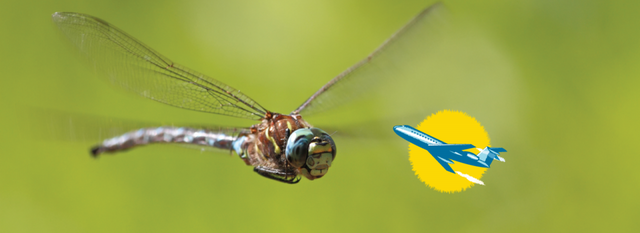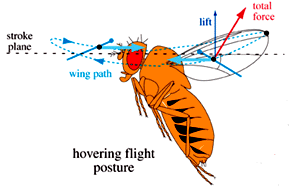Friends steemians, this time we will study the way insects fly and if there is a relationship or not, with the basic principles of aerodynamics applied to airplanes. We will also know the skills to fly dragonflies, which has been the subject of studies by many researchers.
Insects are the most abundant animals on the planet, many of them have the ability to fly, which allows them not only to move from one place to another, but also to capture prey, defend their territories or seduce their partner.
It is incredible to see how some flying insects have the ability to travel hundreds of kilometers, as is the case of migrations by monarch butterflies, which fly back and forth annually 4,000 km between Mexico and Canada. In the same way, in the summer season, the vanesas fly across the deserts of North Africa to the Arctic circle, traveling 15,000 kilometers round trip. But even more surprising, is the "Dragonfly Screen flavescens", which is a flying insect with a capacity to travel more than 18,000 km, this insect travels from India to East Africa and returns.
Dragon-fly:

Source
The flight of the "Dragonfly"
Similar to a helicopter, the dragonfly can perform many maneuvers, as we say in aviation, this insect can fly up and down; It can move to the right and to the left, it can also move forward and backward, land on any surface or simply remain suspended in the air.
These extraordinary insects can fly better than any of the modern aircraft designed by man. That is why the dragonfly has been the subject of study by many researchers to learn the secrets of aerodynamics in these insects.
What is aerodynamics?
Aerodynamics studies the forces acting on an object, an example is when an airplane moves in the air. Through a series of aerodynamic principles we could understand why airplanes fly, and whether or not they exist in insects and birds.
I think some of us, when we were little, asked ourselves: why do airplanes fly? How is it possible that this huge and heavy metal object can be held in the air? Or maybe we have also asked ourselves the same question when we see insects and birds flying, in any case, there are some forces that act on them, that we will understand with the Principles of aerodynamics.
What forces act to keep insects and birds in the air? Will they be the same forces that are applied in airplanes?
In order for an airplane, or a flying insect, to remain in the air, there are several forces acting on them. In the case of an aircraft, there are four forces according to the principles of aerodynamics. , two horizontally and in the opposite direction, and two forces acting vertically, also in the opposite direction. There is another force exerted by the engine to propel the aircraft forward, which opposes air resistance. And to dominate the force exerted by the weight of the aircraft down, there is another opposing lift force, which is the one that lifts the aircraft.

Source
The maneuvers of flying insects can not be overcome by any pilot, no matter how experienced, and this is because the flight of insects does not obey the same aerodynamic laws of aircraft.

Source
Dr. Fernando Minotti, from the Department of Physics of the aforementioned faculty, explains, in an article published in the prestigious journal Physical Review, what forces act on the wings of insects to achieve support even in the most daring movements. SourceThe key to this wonderful ability to fly is what Fernando Minotti tried to discover by appealing to mathematics and making use of the most elementary laws of physics.
"What we developed is an analytical mathematical theory that explains why in insects there is no interruption of the flow around the wing, even with large angles of attack," says Minotti, who is a Conicet researcher. The key seems to be in a vortex or swirl that forms on each of its wings and that persists with all movement changes. This vortex regulates the flow of air at the front edge of the wing and ensures a smooth flow whatever the angle of attack. SourceHeld flight:

Source
Flight mechanism of the "Dragonfly"
Many scientists and researchers have taken an interest in studying the flight mechanism of the "Dragonflies", one of the studies was to determine the elevation at which this flying insect can reach. The lift is the force produced by the movement of the wings in the air, and this is what allows the planes to take off and maintain their rights during the flight.
The researchers with a small instrument that detects small forces, proceeded to measure the elevation generated by different species of dragonflies, arriving to discover that the dragonfly produces three times the elevation of its mass.
Now: How do dragonflies manage to increase the elevation of their mass?
The researchers discovered that by twisting their wings when they go down, small eddies are created in the upper part of them, which causes the air to move quickly over the wings, decreasing its pressure and allowing an incredible elevation.
If the aerodynamic principles of the dragonfly are applied to the airplane, scientists will soon be able to design more efficient aircraft, understanding, of course, that the plans will not be able to fold their wings like dragonflies, but if they can take off more easily, their turns will be faster and landings can be made in small fields or tracks.
Video of the flight of the dragonfly
Posted from my blog with SteemPress : http://oscarcede.vornix.blog/?p=180